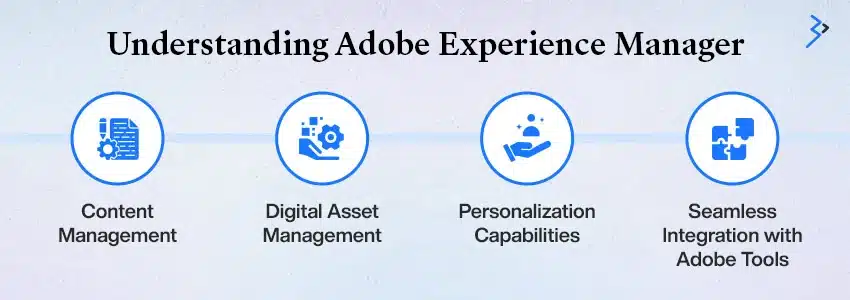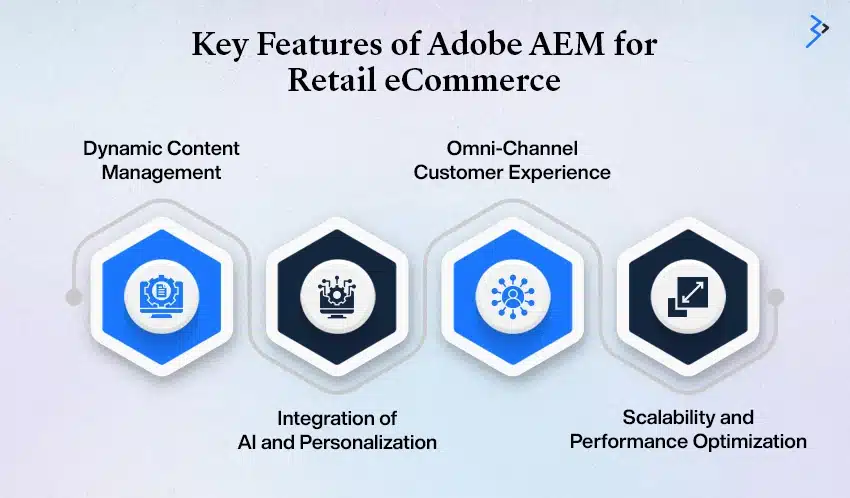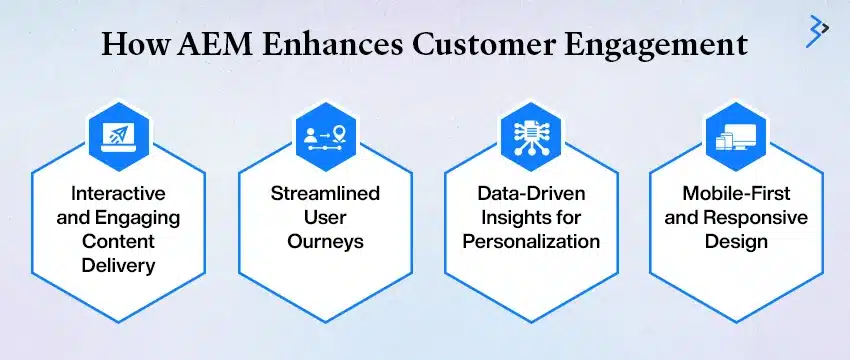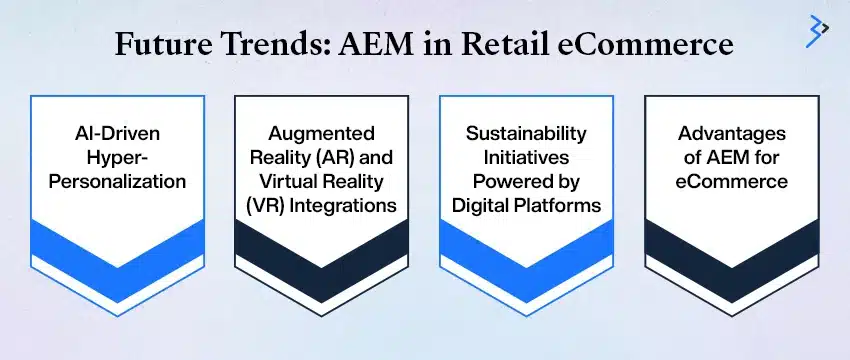Summary:
It’s 2024; your online business needs more than a working website to stand among your competitors.
Besides, your ideal clients won’t waste time around slow-loading websites to complete their orders. They need a platform that provides tailored and smooth customer experiences, loading below one second to continue their search.
Sadly, while most businesses invest in a great site, they often forget to invest in their customer experience. Interestingly, this is where Adobe Experience Manager (AEM) steps in as a versatile digital experience platform that combines content management with sophisticated marketing solutions.
Whether optimizing product releases or developing engaging campaigns, AEM eCommerce solutions provide companies the advantage necessary to remain competitive in this rapid digital landscape. AEM has emerged as an essential tool for achieving eCommerce success by combining creativity and efficiency.
Retailers can create customized customer experiences that address personal preferences and enhance operational productivity through tools such as AEM Marketing Automation.

This article explores how AEM revolutionizes eCommerce operations and enhances customer interaction.
We will discuss:
- Role of AEM in Content Management for eCommerce – How it streamlines product catalog administration and dynamic content distribution.
- Custom Shopping Experiences with AEM – Utilizing data-informed insights to develop personalized customer engagements.
- AEM Marketing Automation – Enhancing marketing efforts and building loyalty with the help of automation.
- Effortless Integration with eCommerce Systems – Exploring how AEM collaborates with various tools to create a cohesive framework.
So continue reading in the following sections as we learn more about AEM and its role in revamping retail businesses.
Understanding Adobe Experience Manager (AEM)

Adobe Experience Manager Services (AEM) is a robust content management solution that empowers businesses to deliver consistent, personalized, and engaging digital experiences. It is designed for flexibility and supports everything from content creation to delivery across websites, mobile apps, and e-commerce platforms.
Core Features of AEM
1. Content Management:
- Simplifies the creation, editing, and publishing of content.
- Includes drag-and-drop features for building web pages and organizing content libraries.
- Offers version control and multilingual support for global businesses.
2. Digital Asset Management (DAM):
- A centralized hub for storing, organizing, and retrieving digital assets like images, videos, and documents.
- Speeds up marketing workflows with automated tagging and AI-powered asset recommendations.
3. Personalization Capabilities:
- Tailors content to individual user preferences using audience segmentation and behavioral analytics.
- Integrates AI to predict user needs and improve engagement rates.
4. Seamless Integration with Adobe Tools:
- Works effortlessly with Adobe Analytics for performance insights and Adobe Commerce for e-commerce solutions.
- It enables a connected workflow, ideal for businesses leveraging the Adobe ecosystem.
AEM for eCommerce
Combining Adobe Commerce with Adobe Experience Manager takes your e-commerce capabilities to the next level. This powerful duo helps you create seamless product catalogs, personalized shopping experiences, and lightning-fast, market-ready solutions that give your business a competitive edge.
Costs and Considerations
Understanding the Costs of Adobe Experience Manager (AEM) is essential because pricing depends on factors like the size of your business, the level of customization you need, and the specific modules you choose. While it can be a significant investment, many businesses find its scalability and return on investment worthwhile, especially when delivering standout digital experiences.
Key Features of Adobe AEM for Retail eCommerce

Adobe Experience Manager (AEM) is a powerful ally for retail eCommerce businesses, helping them create better customer experiences, manage content more efficiently, and boost sales. Let’s break down what makes Adobe AEM eCommerce such a game-changer in an easy-to-understand and relatable way.
1. Dynamic Content Management
Retail brands must manage their content across multiple platforms with ease. AEM’s robust features make this task easier:
- Content Consistency Throughout Channels: AEM guarantees consistent branding and messaging across all platforms, including your website, mobile app, mobile commerce development services and in-store screens. This consistency increases customers’ trust.
- Simplified Multi-Channel Strategies: AEM simplifies the management of a single content repository that can be tailored to various audiences and formats. As a result, campaigns become more flexible and less duplicative.
You can concentrate more on creating captivating stories for your audience and less on balancing content with these tools.
2. Integration of AI and Personalization
Personalized shopping experiences are essential for retaining customers in today’s cutthroat eCommerce market. AEM uses AI to provide:
- Customized Client Experiences: Adobe Sensei helps AEM examine customer behavior to recommend relevant products, offer customized deals, and anticipate needs.
- Real-World Examples: An online shoe retailer might show users sneakers based on their purchases and browsing history, paired with targeted promotions during checkout.
3. Omni-Channel Customer Experience
Retail success depends on a seamless shopping journey, whether customers browse online, shop on mobile, or visit your store. AEM makes this possible by:
- Supporting Fluid Transitions: Shoppers can start browsing on their mobile device, pick up where they left off on a desktop, and finalize their purchase in-store without missing a beat.
- Enabling Integrated Campaigns: Whether launching a seasonal sale or introducing a new product line, AEM helps retailers who use AEM as a cloud service create cohesive campaigns across all touchpoints.
With AEM for Personalized Shopping Experiences, retailers can create a unified experience that keeps customers returning.
4. Scalability and Performance Optimization
Retailers often face unpredictable traffic spikes, especially during events like Black Friday. AEM’s scalability ensures your platform performs flawlessly when it matters most:
- Handling Peak Demand: AEM can effortlessly handle high traffic, ensuring your site doesn’t crash when customers are most eager to shop.
- Cloud Deployment Advantages: Retailers who use AEM as a Cloud Service benefit from automatic updates, faster load times, and reduced operational costs.
With these capabilities, Adobe AEM ensures your eCommerce platform grows with your business.
Why Choose Adobe AEM for Retail eCommerce?
From dynamic content management to personalized shopping experiences, Adobe AEM offers a comprehensive suite of tools tailored to the needs of modern retailers. You can transform your eCommerce strategy by leveraging its AI-driven personalization, omnichannel support, and scalable infrastructure to delight customers at every touchpoint.
How AEM Enhances Customer Engagement

Adobe Experience Manager (AEM) is a powerful tool for businesses looking to enhance customer engagement, particularly in e-commerce. Whether you’re in B2C or B2B, AEM’s capabilities can significantly improve the customer experience.
Here’s a breakdown of how AEM contributes to better engagement and conversion rates across digital platforms.
1. Interactive and Engaging Content Delivery
To capture the attention of today’s digitally savvy consumers, delivering rich and interactive content is essential. AEM excels in providing tools to create immersive, engaging shopping experiences. With features like:
- Videos & Product Demos: AEM enables easy integration of videos and interactive media into your e-commerce site. Product demo videos, tutorials, and 360-degree product views allow customers to thoroughly explore items before purchasing.
- Personalized Product Experiences: AEM tailors the shopping journey based on customer behavior and preferences by allowing dynamic content delivery. This level of personalization boosts engagement and encourages customers to spend more time on your site.
Incorporating such elements makes the shopping experience more enjoyable and increases the likelihood of conversion.
2. Streamlined User Journeys
One of the most important aspects of customer engagement is the ease of navigation through your website. AEM’s powerful features enable businesses to streamline user journeys, making the process smoother and more intuitive.
- Improved Navigation: AEM ensures that your customers can find exactly what they want with minimal effort. Its robust search functionality and intuitive layouts make browsing and purchasing easier, leading to higher satisfaction.
- AEM eCommerce Integration: AEM’s Integration with eCommerce platforms enables seamless product browsing, order tracking, and payment processes. The integration enhances user experience, reducing friction points that can lead to cart abandonment.
- Headless CMS for Flexibility: AEM for B2B eCommerce is particularly beneficial as it offers headless CMS capabilities, which provide flexibility for creating personalized experiences across various digital touchpoints. Whether your customers use a desktop, mobile, or IoT device, AEM adapts to deliver an optimal experience.
3. Data-Driven Insights for Personalization
In today’s digital world, understanding customer behavior is key to personalizing the shopping experience and enhancing Customer Engagement with AEM. Integrating with Adobe Analytics Services gives businesses powerful data insights that can shape content and marketing strategies.
- Behavioral Insights: AEM enables tracking and analyzing customer interactions across all digital channels. These insights allow businesses to customize content, product recommendations, and promotions based on customer interests and buying habits.
- Tailored User Experiences: Companies can dynamically adjust the content and offers presented to customers using data from Adobe Analytics, ensuring that each visit feels relevant and personalized. This boosts engagement and customer loyalty.
4. Mobile-First and Responsive Design
With the increase in shoppers browsing and purchasing via mobile devices, ensuring your site is mobile-friendly is crucial. AEM supports mobile-first and responsive design, meaning your site will automatically adapt to various screen sizes, providing a consistent device experience.
- Responsive Templates: AEM’s responsive templates and adaptive content ensure that your digital store looks and functions perfectly on any device, whether a smartphone, tablet, or desktop.
- Optimized Mobile Experience: With mobile shopping on the rise, AEM provides tools for optimizing mobile performance, load speed, and functionality, which is essential for retaining mobile customers and reducing bounce rates.
Challenges and Solutions in Using AEM
Common Challenges Faced by Retail Businesses
- High Initial Investment
Implementing Adobe Experience Manager (AEM) involves significant upfront costs. This can be a barrier for retail businesses, especially smaller enterprises or those with limited resources. AEM’s rich features and capabilities require substantial investments in both technology and personnel.
- Complexity in Implementation
AEM is a powerful tool, but its complexity can pose challenges during setup. Integrating AEM into existing systems, workflows, and platforms—especially with eCommerce features—can be daunting. Businesses may struggle with aligning AEM’s functionalities with their specific needs, and the learning curve for teams can be steep.
How Businesses Overcome These Challenges
Leveraging AEM’s Partner Ecosystem
Businesses can use AEM’s partner ecosystem to reduce the burden of high upfront costs and complex implementation. Adobe collaborates with trusted partners who offer guidance, support, and customized solutions. These partners help businesses tailor AEM’s capabilities to their unique needs, ensuring smooth implementation and faster adoption.
Customization and Training for In-House Teams
Successful adoption of AEM often involves investing in training and resources for in-house teams. Businesses can ensure their teams are well-prepared to use AEM efficiently by providing comprehensive training programs and ongoing support. AEM’s eCommerce architecture customization options enable companies to align the platform with their goals, particularly around AEM customer data integration and content management.
Using Adobe Sensei for Enhanced Insights
With Adobe Sensei, businesses can harness artificial intelligence and machine learning to streamline workflows and improve decision-making. Adobe Sensei can optimize content personalization, improve product recommendations, and refine customer engagement strategies, making it easier for businesses to provide tailored, data-driven experiences without overwhelming their teams.
Future Trends: AEM in Retail eCommerce

As retail continues to evolve digitally, Adobe Experience Manager (AEM) is at the forefront, shaping the future of eCommerce with its powerful capabilities. Here’s a glimpse at how AEM is revolutionizing retail in the coming years:
1. AI-Driven Hyper-Personalization
With the growing demand for tailored shopping experiences, AEM’s eCommerce Capabilities leverage artificial intelligence to create hyper-personalized content. Retailers can deliver product recommendations, targeted offers, and dynamic content based on user behavior and preferences. This results in a more engaging shopping experience, boosting customer loyalty and conversion rates.
2. Augmented Reality (AR) and Virtual Reality (VR) Integrations
The future of retail will heavily rely on immersive technologies like AR and VR. AEM facilitates seamless integration of these tools, enabling customers to virtually try products, view 3D models, or explore virtual showrooms. This enhances the overall customer experience (CX), helping them make informed decisions and enhancing product engagement.
3. Sustainability Initiatives Powered by Digital Platforms
Sustainability is increasingly a key concern for consumers. AEM helps retailers build eco-friendly brands by managing and showcasing sustainability efforts. Through digital platforms, AEM enables the integration of green initiatives like eco-friendly product lines and transparent sourcing information, fostering a strong connection with environmentally-conscious shoppers.
4. Advantages of AEM for eCommerce
The flexibility and scalability of AEM are crucial for retailers looking to stay ahead in a competitive market. The robust content management, multi-channel capabilities, and personalization features are essential for a seamless shopping experience. As eCommerce grows, the advantages of AEM for eCommerce become even more pronounced in driving business growth and Enhancing CX with AEM.
Related Articles
-
Adobe Commerce Security Best Practices: Safeguarding Your Online Store
In the fast-paced digital era, where online shopping has become a norm, the security of e-commerce platforms is of paramount importance. According to recent studies, a staggering 88% of skilled
-
Using Adobe Commerce for B2B eCommerce: Features You Need to Know!
Summary Adobe Commerce (previously Magento) is a secure, flexible, and comprehensive enterprise eCommerce platform that allows you to create world-class B2C and B2B experiences, all from a single platform. Thanks
-
How Azure DevOps Server Helps Your Business Grow
This is how Jamie Cool, Director of Program Management, Azure DevOps, defines the capabilities of Azure DevOps and Azure DevOps Server in a single statement. And being a Senior DevOps




